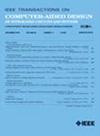iCTS: Iterative and Hierarchical Clock Tree Synthesis With Skew-Latency-Load Tree
IF 2.9
3区 计算机科学
Q2 COMPUTER SCIENCE, HARDWARE & ARCHITECTURE
IEEE Transactions on Computer-Aided Design of Integrated Circuits and Systems
Pub Date : 2025-03-07
DOI:10.1109/TCAD.2025.3549355
引用次数: 0
Abstract
The advancement of modern clock tree synthesis (CTS) encounters a bottleneck, primarily due to the difficulty in achieving multiobjective co-optimization among complex design processes. To concurrently optimize skew, latency, and load capacitance, we propose an iterative and hierarchical CTS framework, which is composed of clustering, topology generation and routing, buffering, and optimization. First, we introduce a capacitance-based metric to achieve adaptive balanced clustering and optimize the cluster results through simulated annealing. Second, to construct a clock tree with lower latency, load capacitance, and skew, we introduce the skew-latency-load tree (SLLT), which combines the advantages of bound skew tree and Steiner shallow-light tree, and we propose an effective SLLT construction algorithm. Third, to further optimize CTS result by buffering, we introduce the critical wirelength evaluation (CWE) to evaluate the capability of each buffer, and propose the insertion delay estimation (IDE) to reduce the evaluation bias during buffering, then design the iterative skew convergence algorithm (ISCA) to achieve complete convergence of skew. We validate our solution using 28 nm process technology. Compared to our method, the commercial tool increases skew, latency, and clock capacitance by 39.5%, 13.0%, and 18.5%, respectively, while the OpenROAD by 101.6%, 50.7%, and 25.5%, respectively.ict:具有倾斜延迟负载树的迭代和分层时钟树合成
现代时钟树合成(CTS)的发展遇到瓶颈,主要是由于复杂设计过程之间难以实现多目标协同优化。为了同时优化倾斜、延迟和负载电容,我们提出了一个迭代的分层CTS框架,该框架由聚类、拓扑生成和路由、缓冲和优化组成。首先,我们引入基于电容的度量来实现自适应平衡聚类,并通过模拟退火优化聚类结果。其次,为了构建具有较低时延、负载电容和偏差的时钟树,我们引入了结合了绑定偏差树和Steiner浅光树优点的倾斜时延负载树(SLLT),并提出了一种有效的SLLT构建算法。第三,为了通过缓冲进一步优化CTS结果,我们引入临界长度评估(CWE)来评估每个缓冲区的能力,提出插入延迟估计(IDE)来减少缓冲期间的评估偏差,然后设计迭代倾斜收敛算法(ISCA)来实现倾斜的完全收敛。我们使用28纳米工艺技术验证了我们的解决方案。与我们的方法相比,商用工具的偏差、延迟和时钟电容分别增加了39.5%、13.0%和18.5%,而OpenROAD分别增加了101.6%、50.7%和25.5%。
本文章由计算机程序翻译,如有差异,请以英文原文为准。
求助全文
约1分钟内获得全文
求助全文
来源期刊
CiteScore
5.60
自引率
13.80%
发文量
500
审稿时长
7 months
期刊介绍:
The purpose of this Transactions is to publish papers of interest to individuals in the area of computer-aided design of integrated circuits and systems composed of analog, digital, mixed-signal, optical, or microwave components. The aids include methods, models, algorithms, and man-machine interfaces for system-level, physical and logical design including: planning, synthesis, partitioning, modeling, simulation, layout, verification, testing, hardware-software co-design and documentation of integrated circuit and system designs of all complexities. Design tools and techniques for evaluating and designing integrated circuits and systems for metrics such as performance, power, reliability, testability, and security are a focus.

 求助内容:
求助内容: 应助结果提醒方式:
应助结果提醒方式:


